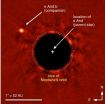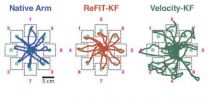(Press-News.org) Hydrogen, the lightest element, can easily dissolve and migrate within metals to make these otherwise ductile materials brittle and substantially more prone to failures.
Since the phenomenon was discovered in 1875, hydrogen embrittlement has been a persistent problem for the design of structural materials in various industries, from battleships to aircraft and nuclear reactors. Despite decades of research, experts have yet to fully understand the physics underlying the problem or to develop a rigorous model for predicting when, where and how hydrogen embrittlement will occur. As a result, industrial designers must still resort to a trial- and-error approach.
Now, Jun Song, an Assistant Professor in Materials Engineering at McGill University, and Prof. William Curtin, Director of the Institute of Mechanical Engineering at Ecole Polytechnique Federale de Lausanne in Switzerland, have shown that the answer to hydrogen embrittlement may be rooted in how hydrogen modifies material behaviours at the nanoscale. In their study, published in Nature Materials, Song and Curtin present a new model that can accurately predict the occurrence of hydrogen embrittlement.
Under normal conditions, metals can undergo substantial plastic deformation when subjected to forces. This plasticity stems from the ability of nano- and micro-sized cracks to generate "dislocations" within the metal – movements of atoms that serve to relieve stress in the material.
"Dislocations can be viewed as vehicles to carry plastic deformation, while the nano- and micro-sized cracks can be viewed as hubs to dispatch those vehicles," Song explains. "The desirable properties of metals, such as ductility and toughness, rely on the hubs functioning well. Unfortunately those hubs also attract hydrogen atoms. The way hydrogen atoms embrittle metals is by causing a kind of traffic jam: they crowd around the hub and block all possible routes for vehicle dispatch. This eventually leads to the material breaking down."
State-of-the-art computer simulations were performed by Song to reveal explicitly how hydrogen atoms move within metals and how they interact with metal atoms. This simulation was followed by rigorous kinetic analysis, to link the nanoscale details with macroscopic experimental conditions.
This model has been applied to predict embrittlement thresholds in a variety of ferritic iron-based steels and produced excellent agreements with experiments. The findings provide a framework for interpreting experiments and designing next-generation embrittlement-resistant structural materials.
### The research was funded in part by the Natural Sciences and Engineering Research Council of Canada, the U.S. Office of Naval Research and by the General Motors/Brown Collaborative Research Lab on Computational Materials.
Study reveals clues to cause of hydrogen embrittlement in metals
Findings could guide design of new embrittlement-resistant materials
2012-11-19
ELSE PRESS RELEASES FROM THIS DATE:
Greenland's viking settlers gorged on seals
2012-11-19
"Our analysis shows that the Norse in Greenland ate lots of food from the sea, especially seals," says Jan Heinemeier, Institute of Physics and Astronomy, Aarhus University.
"Even though the Norse are traditionally thought of as farmers, they adapted quickly to the Arctic environment and the unique hunting opportunities. During the period they were in Greenland, the Norse ate gradually more seals. By the 14th century, seals made up between 50 and 80 per cent of their diet."
The Danish and Canadian researchers are studying the 80 Norse skeletons kept at the University ...
TGen, Scottsdale Healthcare lead worldwide study of new drug for patients with pancreatic cancer
2012-11-19
SCOTTSDALE, Ariz. — A new cancer drug combination demonstrated significant improvement in overall survival of late-stage pancreatic cancer patients compared to those receiving standard treatment, according to results of a Phase III clinical trial led by physicians from Scottsdale Healthcare's Virginia G. Cancer Center Clinical Trials, a partnership with the Translational Genomics Research Institute (TGen).
Physicians at the Virginia G. Piper Cancer Center at Scottsdale Healthcare were first to design a clinical trial to determine the safety, tolerability and effectiveness ...
Can't stop? Smoking less helps
2012-11-19
Countless studies demonstrate the virtues of complete smoking cessation, including a lowered risk of disease, increased life expectancy, and an improved quality of life. But health professionals acknowledge that quitting altogether can be a long and difficult road, and only a small percentage succeed.
Every day, doctors are confronted with patients who either cannot or will not quit, says Vicki Myers, a researcher at Tel Aviv University's Sackler Faculty of Medicine. To address this reality, Myers and her fellow researchers, Dr. Yariv Gerber and Prof. Uri Goldbourt of ...
Astrophysicists identify a 'super-Jupiter' around a massive star
2012-11-19
TORONTO, ON – Astrophysicists at the University of Toronto and other institutions across the United States, Europe and Asia have discovered a 'super-Jupiter' around the massive star Kappa Andromedae. The object, which could represent the first new observed exoplanet system in almost four years, has a mass at least 13 times that of Jupiter and an orbit somewhat larger than Neptune's.
The host star around which the planet orbits has a mass 2.5 times that of the Sun, making it the highest mass star to ever host a directly observed planet. The star can be seen with the naked ...
School exclusion policies contribute to educational failure, study shows
2012-11-19
AUSTIN, Texas — "Zero- tolerance" policies that rely heavily on suspensions and expulsions hinder teens who have been arrested from completing high school or pursuing a college degree, according to a new study from The University of Texas at Austin.
In Chicago, 25,000 male adolescents are arrested each year. One quarter of these arrests occurred in school, according to the Chicago Police Department. The stigma of a public arrest can haunt an individual for years — ultimately stunting academic achievement and transition into adulthood, says David Kirk, associate professor ...
Call to modernize antiquated climate negotiations
2012-11-19
The structure and processes of United Nations climate negotiations are "antiquated", unfair and obstruct attempts to reach agreements, according to research published today.
The findings come ahead of the 18th UN Climate Change Summit, which starts in Doha on November 26.
The study, led by Dr Heike Schroeder from the University of East Anglia (UEA) and the Tyndall Centre for Climate Change Research, argues that the consensus-based decision making used by the United Nations Framework Convention on Climate Change (UNFCCC) stifles progress and contributes to negotiating ...
A better thought-controlled computer cursor
2012-11-19
When a paralyzed person imagines moving a limb, cells in the part of the brain that controls movement still activate as if trying to make the immobile limb work again. Despite neurological injury or disease that has severed the pathway between brain and muscle, the region where the signals originate remains intact and functional.
In recent years, neuroscientists and neuroengineers working in prosthetics have begun to develop brain-implantable sensors that can measure signals from individual neurons, and after passing those signals through a mathematical decode algorithm, ...
Fabrication on patterned silicon carbide produces bandgap to advance graphene electronics
2012-11-19
By fabricating graphene structures atop nanometer-scale "steps" etched into silicon carbide, researchers have for the first time created a substantial electronic bandgap in the material suitable for room-temperature electronics. Use of nanoscale topography to control the properties of graphene could facilitate fabrication of transistors and other devices, potentially opening the door for developing all-carbon integrated circuits.
Researchers have measured a bandgap of approximately 0.5 electron-volts in 1.4-nanometer bent sections of graphene nanoribbons. The development ...
Breakthrough nanoparticle halts multiple sclerosis
2012-11-19
New nanoparticle tricks and resets immune system in mice with MS
First MS approach that doesn't suppress immune system
Clinical trial for MS patients shows why nanoparticle is best option
Nanoparticle now being tested in Type 1 diabetes and asthma
CHICAGO --- In a breakthrough for nanotechnology and multiple sclerosis, a biodegradable nanoparticle turns out to be the perfect vehicle to stealthily deliver an antigen that tricks the immune system into stopping its attack on myelin and halt a model of relapsing remitting multiple sclerosis (MS) in mice, according ...
Research breakthrough selectively represses the immune system
2012-11-19
Reporters, please see "For news media only" box at the end of the release for embargoed sound bites of researchers.
In a mouse model of multiple sclerosis (MS), researchers funded by the National Institutes of Health have developed innovative technology to selectively inhibit the part of the immune system responsible for attacking myelin—the insulating material that encases nerve fibers and facilitates electrical communication between brain cells.
Autoimmune disorders occur when T-cells—a type of white blood cell within the immune system—mistake the body's own tissues ...
LAST 30 PRESS RELEASES:
Modulating key interaction prevents virus from entering cells
Project explores barriers to NHS career progression facing international medical graduates
Jeonbuk National University researchers explore the impact of different seasonings on the flavor perception of Doenjang soup
Two Keck Medicine of USC Hospitals named Leapfrog Top Teaching Hospitals
World-first discovery uncovers how glioblastoma tumours dodge chemotherapy, potentially opening the door to new treatments
A fatal mix-up: How certain gut bacteria drive multiple sclerosis
New AI tool identifies not just genetic mutations, but the diseases they may cause
Deep-learning model predicts how fruit flies form, cell by cell
Combination pills for high blood pressure may simplify treatment, improve long-term health
Immune system keeps mucosal fungi in check
Neurons within the brain use simple rules to localize genetic messages
Electrodes created using light
Second-hand gift-giving is a well-deliberated decision
How human interaction drove evolution to make bears less aggressive
National Poll: Few parents offer teens guidance on healthy eating during holiday season
Cannabis derivatives could provide new ovarian cancer treatments
Raising strong yeast as a petroleum substitute
Clues to the origin of hot Jupiters hidden in their orbits
Canada’s reduced pledge to Global Fund will impact domestic health
1 in 4 children with major traumatic injuries not cared for in pediatric trauma centres
Duke and Duke-NUS’ joint cross-population research to uncover "East-West" differences in disease and care
Scientists to ‘spy’ on cancer- immune cell interactions using quantum technology breakthrough
Tech savvy users have most digital concerns
Making lighter work of calculating fluid and heat flow
Normalizing blood sugar can halve heart attack risk
Lowering blood sugar cuts heart attack risk in people with prediabetes
Study links genetic variants to risk of blinding eye disease in premature infants
Non-opioid ‘pain sponge’ therapy halts cartilage degeneration and relieves chronic pain
AI can pick up cultural values by mimicking how kids learn
China’s ecological redlines offer fast track to 30 x 30 global conservation goal
[Press-News.org] Study reveals clues to cause of hydrogen embrittlement in metalsFindings could guide design of new embrittlement-resistant materials

